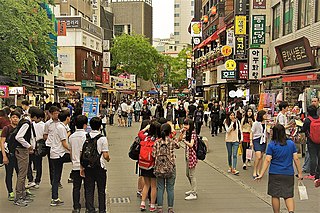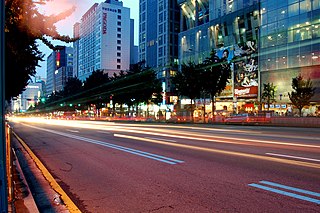
Insa-dong is a dong, or neighborhood of the Jongno-gu district of Seoul. The main street is Insadong-gil, which is connected to a multitude of alleys that lead deeper into the district, with modern galleries and tea shops. At one time it was the largest market for antiques and artworks in Korea.

Jogyesa is the chief temple of the Jogye Order of Korean Buddhism, becoming so in 1936. It thus plays a leading role in the current state of Seon Buddhism in South Korea. The temple was first established in 1395, at the dawn of the Joseon Dynasty; the modern temple was founded in 1910 and initially called "Gakhwangsa". The name was changed to "Taegosa" during the period of Japanese rule, and then to the present name in 1954.

Seodaemun District is one of the 25 districts of Seoul, South Korea.

Gwanak District (Gwanak-gu) is an administrative subdivision (gu) of Seoul, South Korea. It lies on the southern skirt of Seoul, bordering Anyang of Gyeonggi Province. The southern border of Gwanak-gu, bordering Anyang, consists of the craggy ridgeline of Gwanaksan, which dominates the local geography.

The Seoul Korea Temple is the 37th operating temple of The Church of Jesus Christ of Latter-day Saints.

Tapgol Park, formerly Pagoda Park, is a small public park located at 97 Jongno (street), Seoul, South Korea. This park was once a site of Wongaksa. The word tap means "pagoda", and the park gets its name from the Wongaksa Pagoda, a 10 storied stone pagoda located in the park.

Shilleuksa is a Korean Buddhist temple situated against a low hill on the north side of the river Namhan, three kilometers east of Yeoju in Gyeonggi Province, approximately one-hour southeast of Seoul. The only riverside temple in South Korea, Shilleuksa is a sacred pilgrimage site and a repository of seven Treasures. A 500-year-old aromatic juniper tree and a 600-year-old ginkgo tree stand on the temple grounds.

Dongjak District (Dongjak-gu) is one of the 25 gu that make up the city of Seoul, South Korea. Its name was derived from the Dongjaegi Naruteo Ferry, on the Han River which borders the district to the north. It was the 17th gu created in Seoul, after being separated from Gwanak District on April 1, 1980.

Bongeunsa is a Buddhist temple located in Samseong-dong, Gangnam-gu in Seoul, South Korea. It was founded in 794 during the reign of King Wonseong by the monk Yeon-hoe (Korean: 연희), then the highest ranking monk of Silla, and originally named Gyeonseongsa. It is located on the slope of Sudo Mountain, across the street from the COEX Mall.

Onsu Station is a station on the Seoul Subway Line 1. It was the former western terminus of Seoul Subway Line 7. A westward extension of Line 7 was completed in October 2012. It is near the border of Seoul and Bucheon.
Baek Yongseong Jinjong was an important Korean Buddhist master who helped propagate Buddhism in Korea. Primarily grounded in the Seon tradition, he also set about teaching others of Pure Land Buddhism and undertook massive studies and translation efforts of the Buddhist Tripitaka. He was also one of thirty-three national representatives present at the March 1 Movement of 1919, the representative of the Korean Buddhist community. The March 1 Movement is said to have marked the first significant beginning of the Korean Independence Movement, which sought to reach autonomy from Japanese occupation.

Gaeunsa is a Buddhist temple of the Jogye Order in Seoul, South Korea. Founded in 1396 it is located at 15 Anam 5-dong in the Seongbuk-gu area of the city.
Geumseonsa is a Buddhist temple of the Jogye Order in Seoul, South Korea. Believed to have been established before 1405 it is located in 196-1 Gugi-dong in the Jongno-gu area of the city.
Doseonsa is a Buddhist temple of the Jogye Order in Seoul, South Korea. It is located at 264 Ui-dong, in the Gangbuk-gu area of the city and is the largest temple complex on Bukhansan, the most prominent mountain north of Seoul. The temple was dedicated in 862, though none of its original structures survive.
Changcheon-dong is a dong, neighbourhood of Seodaemun-gu in Seoul, South Korea. The sole Mormon Temple in South Korea is located here.
Bongwon-dong is a legal dong, neighbourhood of the Seodaemun-gu district in Seoul, South Korea and is governed by its administrative dong, Sinchon-dong's office. Bongwon-dong has the Bongwon-Temple(Bongwonsa) built by Great master Doseon (827–898) in 889, 3rd year of Jinseong Queen, the 51st of Shilla Dynasty. Bongwon-Temple gives opportunities for visitors to experience "Seoul Lotus Festival" and "Yeongsamjae ritual" annually.
Deoksungsan is a mountain of Chungcheongnam-do, western South Korea. It has an elevation of 495 metres.

The Bukhansanseong is a fortress located in Gyeonggi-do and Seoul, South Korea, dating back to the middle Joseon period. The present fort was completed in 1711, though plans for the structure date back to 1659. The name is also given to a fortress mentioned in the Samguk Sagi, constructed by Gaeru of Baekje in 132 CE, and the two are often conflated although the putative connection is contested.
Ilsan New Town refers to a planned city occupying Ilsandong-gu and Ilsanseo-gu of Goyang.

Cheonggyesa is a temple of the Jogye Order of Korean Buddhism in Uiwang, Cheonggyesan (Seoul/Gyeonggi). The temple was first built in Silla Kingdom era.













